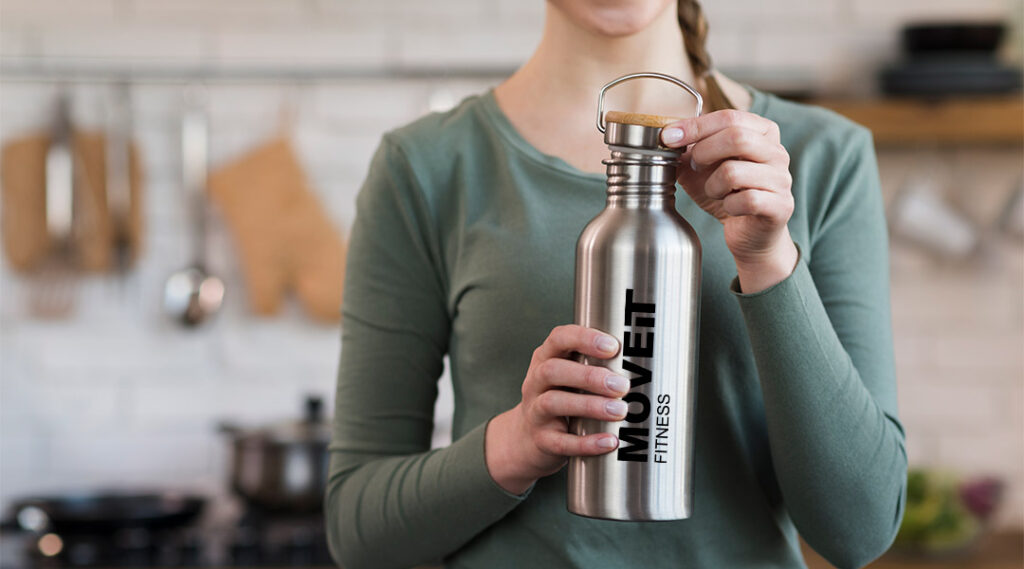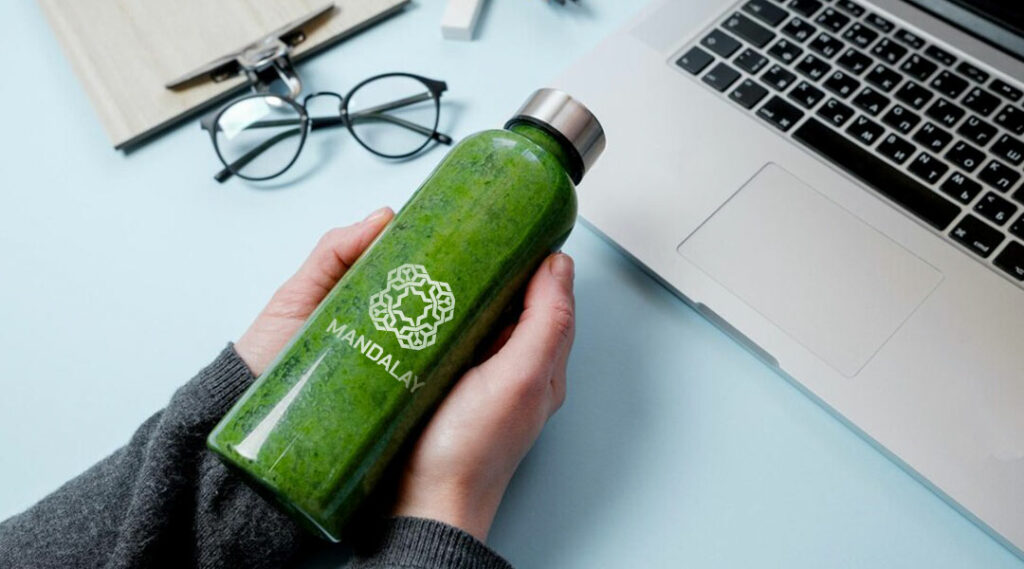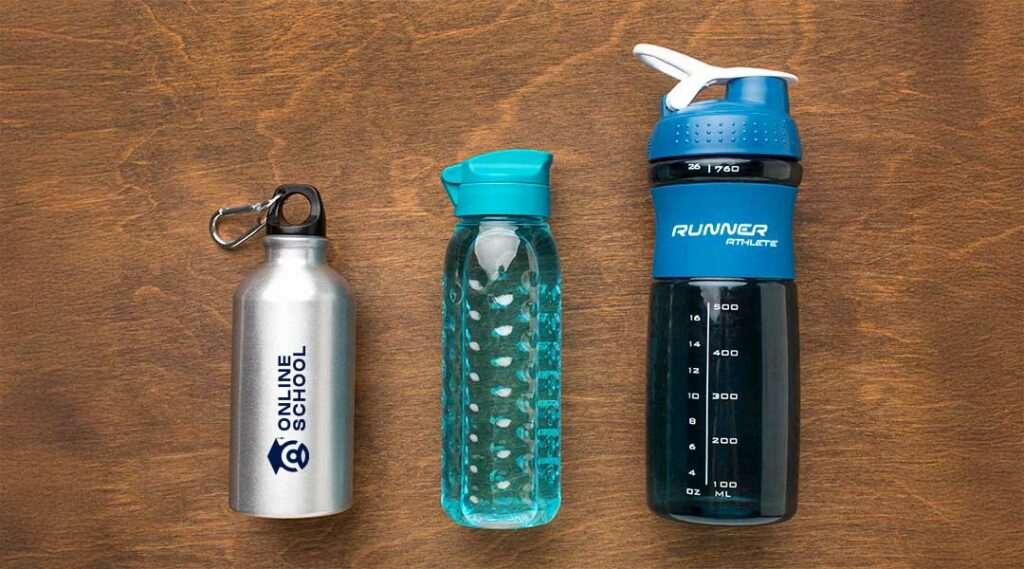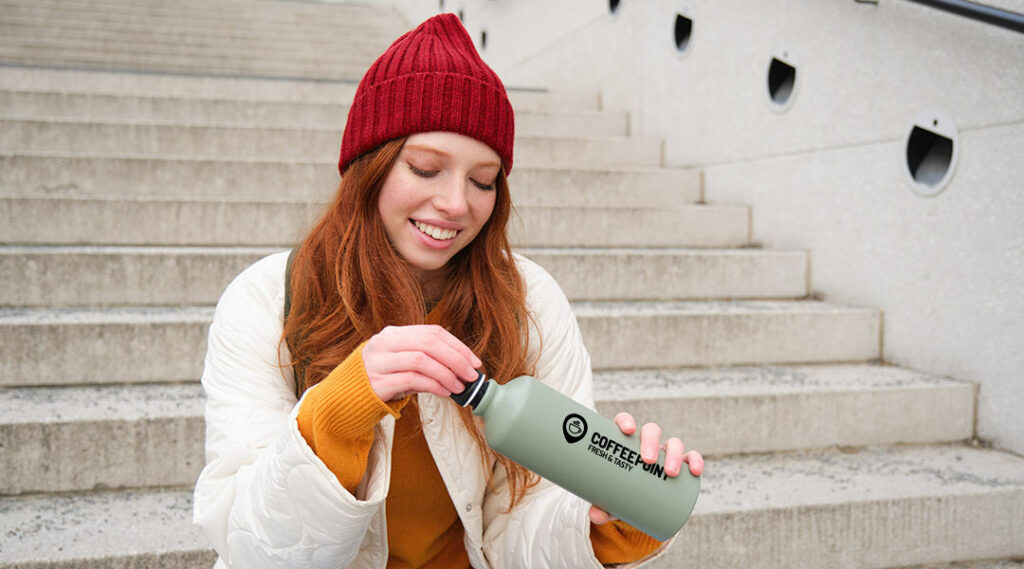
Keeping your reusable water bottle clean is essential to prevent the build-up of bacteria and unpleasant odours. Used daily, water bottles are practical, cost-effective, and environmentally friendly. Choosing a reusable bottle helps reduce plastic consumption significantly and allows you to refill it at various water points throughout the day.
However, since they’re designed for long-term use, regular and proper cleaning is key to keeping your bottle in good condition for as long as possible. Here’s a handy guide with natural and effective tips for keeping your bottle spotless.
What do I Need to Clean my Reusable Water Bottle?
To give your bottle a deep clean, you’ll need:
- 1. – Warm water
- 2. – Washing-up liquid or soap
- 3. – A toothbrush, sponge or bottle brush
- 4. – Bicarbonate of soda or white vinegar
- 5. – Optional: Effervescent cleaning tablets (for bottles or dental appliances)
Cleaning Your Bottle Before First Use
Received a lovely branded bottle from your company and keen to use it right away? At the very least, give it a good rinse before use. Ideally, give it a proper wash, including the cap and seal. Add a few drops of washing-up liquid, fill with warm water, shake, and rinse thoroughly. This is important to remove dust or any residue from manufacturing or storage.
Top tip: It’s actually recommended to do this after every use!
How to Clean a Plastic or Stainless Steel Bottle
The most straightforward daily routine for plastic or stainless steel bottles is to add a few drops of washing-up liquid and warm water, screw the lid on, and give it a good shake. Then, open it up and use a long brush or bottle brush to scrub the inside walls.
Pay extra attention to the neck and lid of the bottle — this is where bacteria tend to build up. Use a sponge and soap to clean these parts thoroughly.
Finally, rinse the bottle well to remove any remaining soap.
Warning: Never pour boiling water into a plastic bottle as it may warp or become damaged.
How to Clean a Smelly Water Bottle

Filled your bottle with something other than water? Whether it’s coffee, sweet drinks, tea, or lemon juice, mould can form if the bottle isn’t washed straight away.
Don’t worry — there are solutions!
Bicarbonate of Soda
If your bottle smells musty or has been closed with sugary drink residue inside, bicarbonate of soda can work wonders.
- – Wash the bottle as usual with warm water and washing-up liquid.
- – Fill it with warm water (not too hot for plastic), and add a teaspoon of bicarbonate of soda.
- – Shake well and leave to soak for several hours or overnight.
- – Rinse thoroughly and let it air dry upside down to drain completely.
White Vinegar
You can use the same process with white vinegar. Mix roughly half vinegar and half warm water, and fill the bottle to the top so the neck is also covered. Leave to sit for several hours.
What About the Cap?
The cap is a key area for bacteria and odours, so it deserves special attention. Wash it separately using warm water and soap. If possible, unscrew the seal and clean it with a toothbrush. Just like the bottle, you can soak both in warm water mixed with white vinegar or bicarbonate of soda for a deep clean.
Bonus Tip: Effervescent Cleaning Tablets
A lesser-known but effective tip is to use effervescent tablets — the kind designed for bottles, dentures or dental appliances.
After washing your bottle with warm water and washing-up liquid, fill it up again and drop in a tablet. Let it sit for at least 20 minutes.
The fizzing action helps lift grime and removes bacteria, as these products are designed for oral hygiene.
Mistakes to Avoid

Never use bleach to disinfect your bottle. While it kills bacteria, it’s highly toxic and damaging to the material. The cleaning methods listed above are more than enough to eliminate mould and odours.
Avoid putting your bottle in the freezer. Frozen liquid expands and may cause your bottle to crack or even explode. For keeping drinks cool, try an insulated sleeve or invest in an insulated bottle or thermos.
Can I Put My Water Bottle in the Dishwasher?
Many bottles can go in the dishwasher, but check the manufacturer’s guidelines. Some advise against it, especially if your bottle has printed designs or special coatings that may be damaged. You can usually pop the lid and seal in the dishwasher separately.
Storing Your Bottle Properly

Once your bottle is washed and air-dried, make sure to store it with the cap off. This allows air to circulate freely, preventing mould and unpleasant smells. Before using it again, give it a quick rinse to remove any dust.
How Often Should I Clean My Water Bottle?
Ideally, clean your bottle daily — especially if it’s been filled with anything other than water (e.g., juice, tea or sweet drinks). If used only for water, a quick daily rinse with hot soapy water is fine, followed by a more thorough cleaning once or twice a week using vinegar, bicarbonate of soda, or cleaning tablets.
Here’s why regular cleaning is essential:
- – To maintain hygiene: Bottles can become a breeding ground for bacteria due to moisture and stagnant water. Regular cleaning prevents health risks.
- – To preserve the taste: Build-up of residue, minerals or impurities can alter the taste of your drinks. Cleaning ensures a fresh taste every time.
- – To extend your bottle’s lifespan: Residue can damage the bottle over time. Keeping it clean helps it last longer and stay in good condition.
Bottle Cleaning at a Glance: Summary Table
| Issue | Solution | Recommended Frequency |
| Daily cleaning | Warm water + washing-up liquid | After each use |
| Deep clean | Hot water + white vinegar or bicarbonate of soda | 1–2 times a week |
| Remove odours | Soak with water + bicarbonate or vinegar | As soon as smells appear |
| Clean lid & seal | Wash separately with soap + toothbrush | Every 2–3 days |
| Effervescent tablets | Warm water + tablet | Occasionally, for extra cleaning |
| Avoid | Bleach, boiling water in plastic, freezer | Always |
| Storage after cleaning | Air-dry with lid off | After each wash |
Conclusion: Our Top Tips for Cleaning Your Bottle
Taking care of your reusable water bottle is a simple habit that ensures hygiene, keeps your drinks tasting fresh, and extends the bottle’s lifespan. A quick daily wash with soapy water and a weekly deep clean using vinegar or bicarbonate of soda will keep it in top shape — and odour-free.
With these tips, you can enjoy your bottle with peace of mind. Why not gift them to your employees as well? It’s a great way to promote sustainability and reduce your company’s carbon footprint.